Multi-Source Data-Driven Spatiotemporal Study on Integrated Ecosystem Service Value for Sustainable Ecosystem Management in Lake Dianchi Basin
Abstract
:1. Introduction
2. Research Area and Materials
2.1. Study Area
2.2. Data Sources and Processing
2.3. Research Methodology
2.3.1. Single-Factor Accounting of LSV, CSV, and NPPV
- (1)
- Analysis and calculation of LSV
- (2)
- Analysis and calculation of CSV
- (3)
- Analysis and calculation of NPPV
2.3.2. Integrated Evaluation Index System
- (1)
- CSV and NPPV effective carbon value conversion.
- (2)
- Evaluation index system.
- (3)
- Analysis of entropy weight by TOPSIS method.
2.3.3. Integrated Evaluation Index Spatial Autocorrelation Analysis
2.3.4. COG (Center of Gravity) Analysis
2.3.5. CA-MC Model Prediction Analysis
3. Results and Analysis
3.1. Distribution Characteristics of LSV, CSV, and NPPV
3.2. Analysis of Structural Trend Characteristics of LSV, CSV, and NPPV
3.3. IESV Spatiotemporal and Quantitative Change Characteristics
3.4. IESV Spatiotemporal Prediction Based on CA-MC Model
4. Discussion
4.1. IESV Changing Trend and Land Efficiency
4.2. Land Use Comprehensive Assessment
4.3. Future-Based IESV System Stability
5. Conclusions
Author Contributions
Funding
Institutional Review Board Statement
Informed Consent Statement
Data Availability Statement
Acknowledgments
Conflicts of Interest
References
- Zhang, Y.; Hu, X.; Wei, B.; Zhang, X.; Tang, L.; Chen, C.; Wang, Y.; Yang, X. Spatiotemporal exploration of ecosystem service value, landscape ecological risk, and their interactive relationship in Hunan Province, Central-South China, over the past 30 years. Ecol. Indic. 2023, 156, 111066. [Google Scholar] [CrossRef]
- Chen, Z.; Zhang, X. Value of ecosystem services in China. Chin. Sci. Bull. 2000, 45, 870–876. [Google Scholar] [CrossRef]
- Robert, C.; Ralph, d’.A.; Rudolf, d.G.; Stephen, F.; Monica, G.; Bruce, H.; Marjan, B. The value of the world’s ecosystem services and natural capital. Nature 1997, 387, 253–260. [Google Scholar] [CrossRef]
- Engdaye, M.; Sileshi, D.; Mekuria, A.; Wondimagegn, M. Impact of Land Use Land Cover Changes on Ecosystem Service Values: Implication for Landscape Management. J. Landsc. Ecol. 2025, 18, 61–85. [Google Scholar] [CrossRef]
- Feng, X.; Huang, H.; Wang, Y.; Tian, Y.; Li, L. Identification of Ecological Sources Using Ecosystem Service Value and Vegetation Productivity Indicators: A Case Study of the Three-River Headwaters Region, Qinghai-Tibetan Plateau, China. Remote Sens. 2024, 16, 1258. [Google Scholar] [CrossRef]
- Walther, F.; Barton, D.N.; Schwaab, J.; Kato-Huerta, J.; Immerzeel, B.; Adamescu, M.; Andersen, E.; Coyote, M.V.A.; Arany, I.; Balzan, M.; et al. Uncertainties in ecosystem services assessments and their implications for decision support-A semi-systematic literature review. Ecosyst. Serv. 2025, 73, 101714. [Google Scholar] [CrossRef]
- Dushkova, D.; Konstantinova, A.; Matasov, V.; Gaeva, D.; Dovletyarova, E.; Taherkhani, M. Urban ecosystem services research in Russia: Systematic review on the state of the art. Ambio 2024, 54, 1–26. [Google Scholar] [CrossRef]
- Guo, Y.; He, P.; Chen, P.; Zhang, L. Ecological Evaluation of Land Resources in the Yangtze River Delta Region by Remote Sensing Observation. Land 2024, 13, 1155. [Google Scholar] [CrossRef]
- Zhang, L.; Zhang, M.; Guo, Y. Entropy-Weighted TOPSIS-Based Ecological Environment Driving Factors in the Chaohu Lake Rim Region Temporal and Spatial Differentiation Study. Pol. J. Environ. Stud. 2024, 33, 5459–5471. [Google Scholar] [CrossRef]
- Pourebrahim, S.; Mokhtar, M.B. Conservation priority assessment of the coastal area in the Kuala Lumpur mega-urban region using extent analysis and TOPSIS. Env. Earth Sci. 2016, 75, 348. [Google Scholar] [CrossRef]
- Mirli, A.; Bakas, T.; Latinopoulos, D.; Kagalou, I.; Spiliotis, M. Participatory Management of a Mediterranean Lagoon Complex Social-Ecological System Using Intuitionistic Fuzzy TOPSIS. Sustainability 2024, 16, 10647. [Google Scholar] [CrossRef]
- Du, H.; Zhao, L.; Zhang, P.; Li, J.; Yu, S. Ecological compensation in the Beijing-Tianjin-Hebei region based on ecosystem services flow. J. Environ. Manag. 2023, 331, 117230. [Google Scholar] [CrossRef] [PubMed]
- Zhang, Z.; Li, J.; Lu, Y.; Yang, L.; Hu, Z.; Li, C.; Yang, X. Temporal and spatial changes in land use and ecosystem service value based on SDGs’ reports: A case study of Dianchi Lake Basin, China. Environ. Sci. Pollut. Res. 2023, 30, 31421–31435. [Google Scholar] [CrossRef] [PubMed]
- Wang, G.; Cushman, S.A.; Wan, H.Y.; Li, H.; Szabó, Z.; Ning, D.; Jombach, S. Ecological Connectivity Networks for Multi-dispersal Scenarios Using UNICOR Analysis in Luohe Region, China. J. Digit. Landsc. Archit. 2021, 10, 230–244. [Google Scholar] [CrossRef]
- Atesoglu, A.; Ayyildiz, E.; Karakaya, I.; Bulut, F.S.; Serengil, Y. Land cover and drought risk assessment in Türkiye’s mountain regions using neutrosophic decision support system. Env. Monit Assess. 2024, 196, 1046. [Google Scholar] [CrossRef]
- Yin, Z.; Feng, Q.; Zhu, R.; Wang, L.; Chen, Z.; Fang, C.; Lu, R. Analysis and prediction of the impact of land use/cover change on ecosystem services value in Gansu province, China. Ecol. Indic. 2023, 154, 110868. [Google Scholar] [CrossRef]
- Li, G.; Cheng, G.; Liu, G.; Chen, C.; He, Y. Simulating the Land Use and Carbon Storage for Nature-Based Solutions (NbS) under Multi-Scenarios in the Three Gorges Reservoir Area: Integration of Remote Sensing Data and the RF-Markov-CA-InVEST Model. Remote Sens. 2023, 15, 5100. [Google Scholar] [CrossRef]
- Xia, X.; Shirong, Q.; Honglei, J.; Tong, Z. Ecosystem vulnerability to extreme climate in coastal areas of China. Environ. Res. Lett. 2023, 18, 124028. [Google Scholar] [CrossRef]
- Lyu, J.; Fu, X.; Lu, C.; Zhang, Y.; Luo, P.; Guo, P.; Huo, A.; Zhou, M. Quantitative assessment of spatiotemporal dynamics in vegetation NPP, NEP and carbon sink capacity in the Weihe River Basin from 2001 to 2020. J. Clean. Prod. 2023, 428, 139384. [Google Scholar] [CrossRef]
- Luo, Y.; Zhao, Y.; Yang, K.; Chen, K.; Pan, M.; Zhou, X. Dianchi Lake watershed impervious surface area dynamics and their impact on lake water quality from 1988 to 2017. Environ. Sci. Pollut. Res. 2018, 25, 29643–29653. [Google Scholar] [CrossRef]
- Wang, Y.; Wang, W.; Wang, Z.; Li, G.; Liu, Y. Regime shift in Lake Dianchi (China) during the last 50 years. J. Oceanol. Limnol. 2018, 36, 1075–1090. [Google Scholar] [CrossRef]
- Liu, J.; Kuang, W.; Zhang, Z.; Xu, X.; Qin, Y.; Ning, J.; Zhou, W.; Zhang, S.; Li, R.; Yan, C. Spatiotemporal characteristics, patterns, and causes of land-use changes in China since the late 1980s. J. Geogr. Sci. 2014, 24, 195–210. [Google Scholar] [CrossRef]
- Xu, X.; Liu, J.; Zhang, S.; Li, R.; Yan, C.; Wu, S. China Multi Period Land Use Remote Sensing Monitoring Dataset (CNLUCC); Resource and Environmental Science Data Registration and Publishing System; Resource and Environment Data Cloud Platform: Beijing, China, 2018. [Google Scholar] [CrossRef]
- Xie, G.; Zhang, C.; Zhen, L.; Zhang, L. Dynamic changes in the value of China’s ecosystem services. Ecosyst. Serv. 2017, 26, 146–154. [Google Scholar] [CrossRef]
- Niu, Y.; Xie, G.; Xiao, Y.; Qin, K.; Gan, S.; Liu, J. Spatial and Temporal Changes of Ecosystem Service Value in Airport Economic Zones in China. Land 2021, 10, 1054. [Google Scholar] [CrossRef]
- Xiao, Y.; Huang, M.; Xie, G.; Zhen, L. Evaluating the impacts of land use change on ecosystem service values under multiple scenarios in the Hunshandake region of China. Sci. Total Environ. 2022, 850, 158067. [Google Scholar] [CrossRef]
- Zhai, Y.; Li, W.; Shi, S.; Gao, Y.; Chen, Y.; Ding, Y. Spatio-temporal dynamics of ecosystem service values in China’s Northeast Tiger-Leopard National Park from 2005 to 2020: Evidence from environmental factors and land use/land cover changes. Ecol. Indic. 2023, 155, 110734. [Google Scholar] [CrossRef]
- Fu, Y.; Huang, M.; Gong, D.; Lin, H.; Fan, Y.; Du, W. Dynamic Simulation and Prediction of Carbon Storage Based on Land Use/Land Cover Change from 2000 to 2040: A Case Study of the Nanchang Urban Agglomeration. Remote Sens. 2023, 15, 4645. [Google Scholar] [CrossRef]
- Chen, X.; He, L.; Luo, F.; He, Z.; Bai, W.; Xiao, Y.; Wang, Z. Dynamic characteristics and impacts of ecosystem service values under land use change: A case study on the Zoigê plateau, China. Ecol. Inform. 2023, 78, 102350. [Google Scholar] [CrossRef]
- Minmin, Z.; Zhibin, H.; Jun, D.; Longfei, C.; Pengfei, L.; Shu, F. Assessing the effects of ecological engineering on carbon storage by linking the CA-Markov and InVEST models. Ecol. Indic. 2019, 98, 29–38. [Google Scholar] [CrossRef]
- Chen, L.; Zhang, C.; Xie, G.; Liu, C.; Wang, H.; Li, Z.; Pei, S.; Qiao, Q. Vegetation Carbon Storage, Spatial Patterns and Response to Altitude in Lancang River Basin, Southwest China. Sustainability 2016, 8, 110. [Google Scholar] [CrossRef]
- Kang, J.; Zhang, L.; Meng, Q.; Wu, H.; Hou, J.; Pan, J.; Wu, J. Land Use and Carbon Storage Evolution Under Multiple Scenarios: A Spatiotemporal Analysis of Beijing Using the PLUS-InVEST Model. Sustainability 2025, 17, 1589. [Google Scholar] [CrossRef]
- Gao, F.; Xin, X.; Song, J.; Li, X.; Zhang, L.; Zhang, Y.; Liu, J. Simulation of LUCC Dynamics and Estimation of Carbon Stock under Different SSP-RCP Scenarios in Heilongjiang Province. Land 2023, 12, 1665. [Google Scholar] [CrossRef]
- Zhou, Y.; Shao, M.; Li, X. Temporal and Spatial Evolution, Prediction, and Driving-Factor Analysis of Net Primary Productivity of Vegetation at City Scale: A Case Study from Yangzhou City, China. Sustainability 2023, 15, 14518. [Google Scholar] [CrossRef]
- Li, K.; Hou, Y.; Andersen, P.S.; Xin, R.; Rong, Y.; Skov-Petersen, H. An ecological perspective for understanding regional integration based on ecosystem service budgets, bundles, and flows: A case study of the Jinan metropolitan area in China. J. Environ. Manag. 2022, 305, 114371. [Google Scholar] [CrossRef] [PubMed]
- Zhang, H.; van Kooten, G.C.; Yue, C.; Wang, Z. Carbon sink potential and the cost of afforestation in northwest China when accounting for ecosystem service value. J. Environ. Manag. 2025, 374, 124051. [Google Scholar] [CrossRef] [PubMed]
- Ge, J.; Zhang, Z.; Lin, B. Towards carbon neutrality: How much do forest carbon sinks cost in China? Environ. Impact Assess. Rev. 2023, 98, 106949. [Google Scholar] [CrossRef]
- Zhang, Z.; Zhang, X.; Zhu, J.; Luo, Y.; Hou, Z.; Chu, J. Cost of Carbon Sequestration of Main Plantation types in Guangxi. Sci. Silvae Sin. 2010, 46, 16–22. [Google Scholar] [CrossRef]
- Zhou, R.W.; Peng, M.C.; Zhang, Y.P. The simulation research of carbon storage and sequestration potential of main forest vegetation in Yunnan Province. J. Yunnan Univ. Nat. Sci. Ed. 2017, 39, 1089–1103. [Google Scholar] [CrossRef]
- Zijia Liu, Spatio-temporal Variation Analysis of Net Primary Productivity of Vegetation in Henan Based on MODIS Remote Sensing Data. Geosci. Remote Sens. 2025, 8, 21–28. [CrossRef]
- Ni, J. Net primary productivity in forests of China: Scaling-up of national inventory data and comparison with model predictions. For. Ecol. Manag. 2003, 176, 485–495. [Google Scholar] [CrossRef]
- IEA. Coal 2020; IEA: Paris, France, 2020; Available online: https://www.iea.org/reports/coal-2020 (accessed on 1 December 2020).
- Li, X.; Yu, X.; Hou, X.; Liu, Y.; Li, H.; Zhou, Y.; Xia, S.; Liu, Y.; Duan, H.; Wang, Y.; et al. Valuation of Wetland Ecosystem Services in National Nature Reserves in China’s Coastal Zones. Sustainability 2020, 12, 3131. [Google Scholar] [CrossRef]
- National Research Council. Valuing Ecosystem Services: Toward Better Environmental Decision-Making; The National Academies Press: Washington, DC, USA, 2005. [Google Scholar] [CrossRef]
- Deng, B.; Yang, W.; Huang, J.; Mu, N. Estimating the change of vegetation coverage of the upstream of minjiang river by using remote-sensing images. Rev. Int. Contam. Ambiental 2019, 35, 11–22. [Google Scholar] [CrossRef]
- Cao, X.; Wei, C.; Xie, D. Evaluation of scale management suitability based on the entropy-TOPSIS method. Land 2021, 10, 416. [Google Scholar] [CrossRef]
- Wei, Z.; Ji, D.; Yang, L. Comprehensive evaluation of water resources carrying capacity in Henan Province based on entropy weight TOPSIS—Coupling coordination—Obstacle model. Environ. Sci. Pollut. Res. 2023, 30, 1–19. [Google Scholar] [CrossRef] [PubMed]
- Xu, Y.; Liu, R.; Xue, C.; Xia, Z. Ecological Sensitivity Evaluation and Explanatory Power Analysis of the Giant Panda National Park in China. Ecol. Indic. 2023, 146, 109792. [Google Scholar] [CrossRef]
- Wang, J.; Zhang, Z.; Liu, Y. Spatial shifts in grain production increases in China and implications for food security. Land Use Policy 2018, 74, 204–213. [Google Scholar] [CrossRef]
- Li, D.; Yang, J.; Hu, T.; Wang, G.; Cushman, S.A.; Wang, X.; László, K.; Su, R.; Yuan, L.; Li, B. The seeds of ecological recovery in urbanization–Spatiotemporal evolution of ecological resiliency of Dianchi Lake Basin, China. Ecol. Indic. 2023, 153, 110431. [Google Scholar] [CrossRef]
- Cui, L.; Zhao, Y.; Liu, J.; Wang, H.; Han, L.; Li, J.; Sun, Z. Vegetation coverage prediction for the Qinling mountains using the CA–Markov model. ISPRS Int. J. Geo-Inf. 2021, 10, 679. [Google Scholar] [CrossRef]
- Da Cunha, E.R.; Santos, C.A.G.; da Silva, R.M.; Bacani, V.M.; Pott, A. Future scenarios based on a CA-Markov land use and land cover simulation model for a tropical humid basin in the Cerrado/Atlantic forest ecotone of Brazil. Land Use Policy 2021, 101, 105141. [Google Scholar] [CrossRef]
- Fang, Z.; Ding, T.; Chen, J.; Xue, S.; Zhou, Q.; Wang, Y.; Wang, Y.; Huang, Z.; Yang, S. Impacts of land use/land cover changes on ecosystem services in ecologically fragile regions. Sci. Total Environ. 2022, 831, 154967. [Google Scholar] [CrossRef]
- Kohestani, N.; Rastgar, S.; Heydari, G.; Jouibary, S.S.; Amirnejad, H. Spatiotemporal modeling of the value of carbon sequestration under changing land use/land cover using InVEST model: A case study of Nour-rud Watershed, Northern Iran. Environ. Dev. Sustain. 2023, 26, 14477–14505. [Google Scholar] [CrossRef]
- Wei, X.; Yang, J.; Luo, P.; Lin, L.; Lin, K.; Guan, J. Assessment of the variation and influencing factors of vegetation NPP and carbon sink capacity under different natural conditions. Ecol. Indic. 2022, 138, 108834. [Google Scholar] [CrossRef]
- Long, X.; Lin, H.; An, X.; Chen, S.; Qi, S.; Zhang, M. Evaluation and analysis of ecosystem service value based on land use/cover change in Dongting Lake wetland. Ecol. Indic. 2022, 136, 108619. [Google Scholar] [CrossRef]
- Liu, C.; Sun, W.; Li, P. Characteristics of spatiotemporal variations in coupling coordination between integrated carbon emission and sequestration index: A case study of the Yangtze River Delta, China. Ecol. Indic. 2022, 135, 108520. [Google Scholar] [CrossRef]
- Zhou, P.; Zhang, H.; Huang, B.; Ji, Y.; Peng, S.; Zhou, T. Are productivity and biodiversity adequate predictors for rapid assessment of forest ecosystem services values? Ecosyst. Serv. 2022, 57, 101466. [Google Scholar] [CrossRef]
- Li, L.; Zeng, Z.; Zhang, G.; Duan, K.; Liu, B.; Cai, X. Exploring the Individualized Effect of Climatic Drivers on MODIS Net Primary Productivity through an Explainable Machine Learning Framework. Remote Sens. 2022, 14, 4401. [Google Scholar] [CrossRef]
- Kong, L.; Wu, L.; Liu, J.; Liu, C.; Wang, H.; Li, L.; Xu, H.; Wang, J.; Tang, X.; Hu, W. Ensemble algorithms for modeling forest live fuel loads and multivariate probability proportional to size sampling in Kunming, Yunnan, China. J. Clean. Prod. 2023, 425, 138751. [Google Scholar] [CrossRef]
- Guan, X.; Shen, H.; Li, X.; Gan, W.; Zhang, L. A long-term and comprehensive assessment of the urbanization-induced impacts on vegetation net primary productivity. Sci. Total. Environ. 2019, 669, 342–352. [Google Scholar] [CrossRef]
- Millennium Ecosystem Assessment. Global Change & Human Health. 2001, 2, 118. [CrossRef]
- Kumar, P. (Ed.) The Economics of Ecosystems and Biodiversity: Ecological and Economic Foundations, 1st ed.; Routledge: London, UK, 2011. [Google Scholar] [CrossRef]
- Yang, H.; Yu, J.; Xu, W.; Wu, Y.; Lei, X.; Ye, J.; Geng, J.; Ding, Z. Long-time series ecological environment quality monitoring and cause analysis in the Dianchi Lake Basin, China. Ecol. Indic. 2023, 148, 110084. [Google Scholar] [CrossRef]
- Wang, Z.; Liu, X.; Wang, W.; Li, W. Water quality evaluation of typical Lake Wetland Parks around Dianchi Lake. E3S Web Conf. 2022, 358, 02014. [Google Scholar] [CrossRef]
- Wang, R.; Xu, X.; Bai, Y.; Alatalo, J.M.; Yang, Z.; Yang, W.; Yang, Z. Impacts of urban land use changes on ecosystem services in Dianchi Lake Basin, China. Sustainability 2021, 13, 4813. [Google Scholar] [CrossRef]
- Yan, W.; Wang, J.; Zou, H.; Min, M.; Duan, X. Modeling economic-environmental-ecological trade-offs for non-point source control strategies: A case study of Dianchi lake watershed, China. Ecol. Indic. 2024, 158, 111494. [Google Scholar] [CrossRef]
- Li, Z.; Zhao, Z.; Zhang, T. Livability evaluation of urban environment based on Google Earth Engine and multi-source data: A case study of Kunming, China. Ecol. Indic. 2024, 169, 112968. [Google Scholar] [CrossRef]
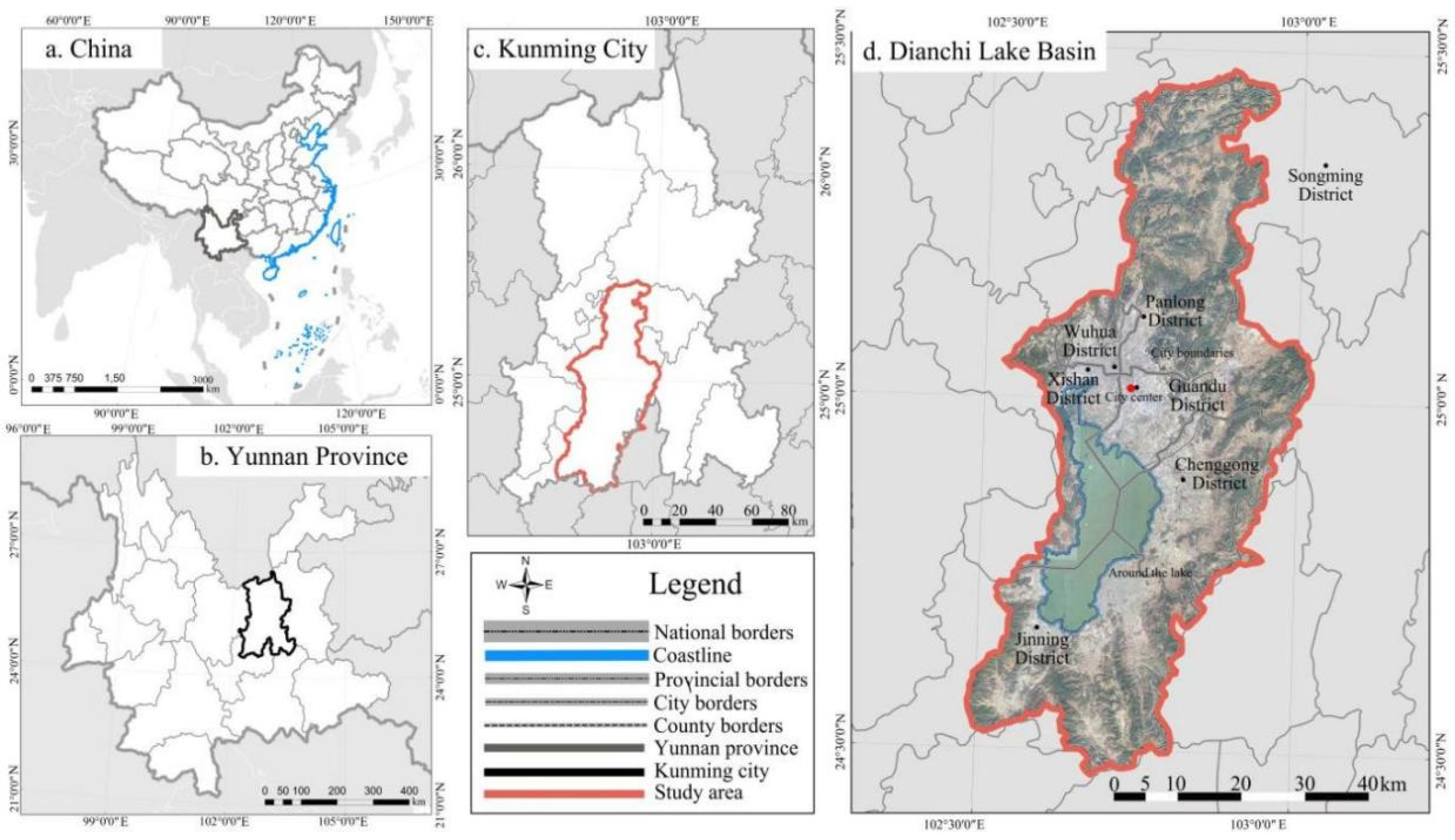
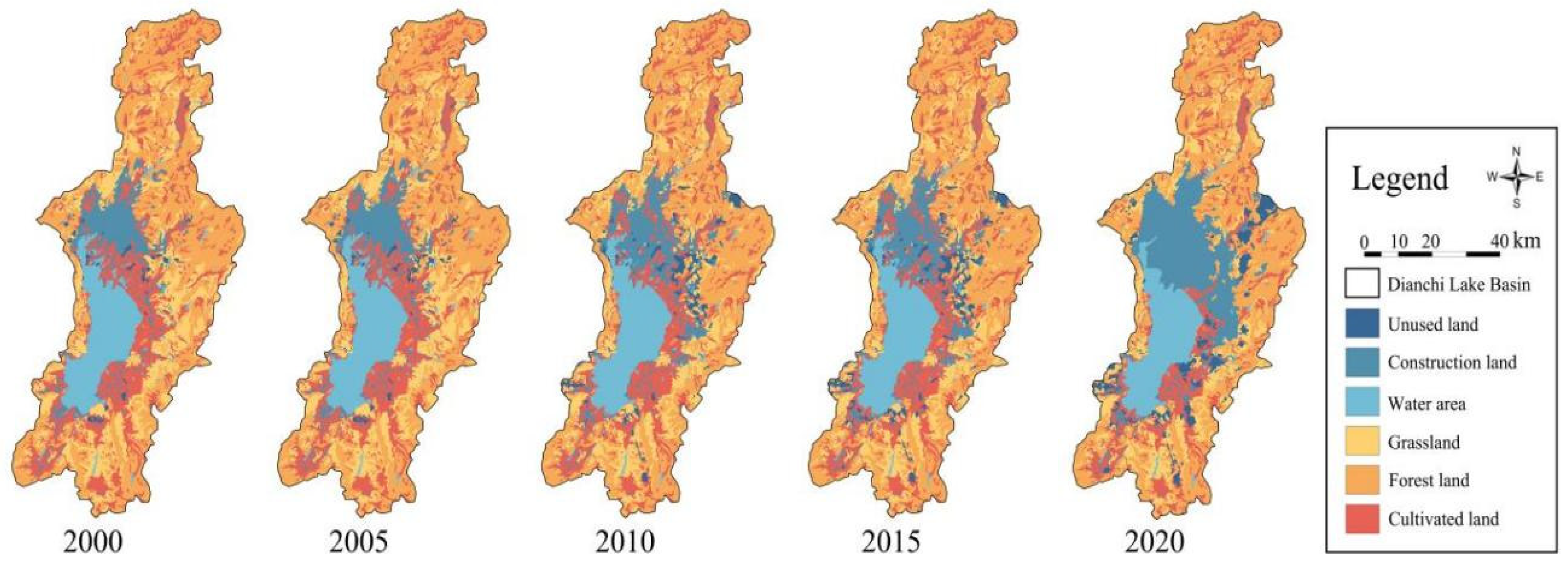
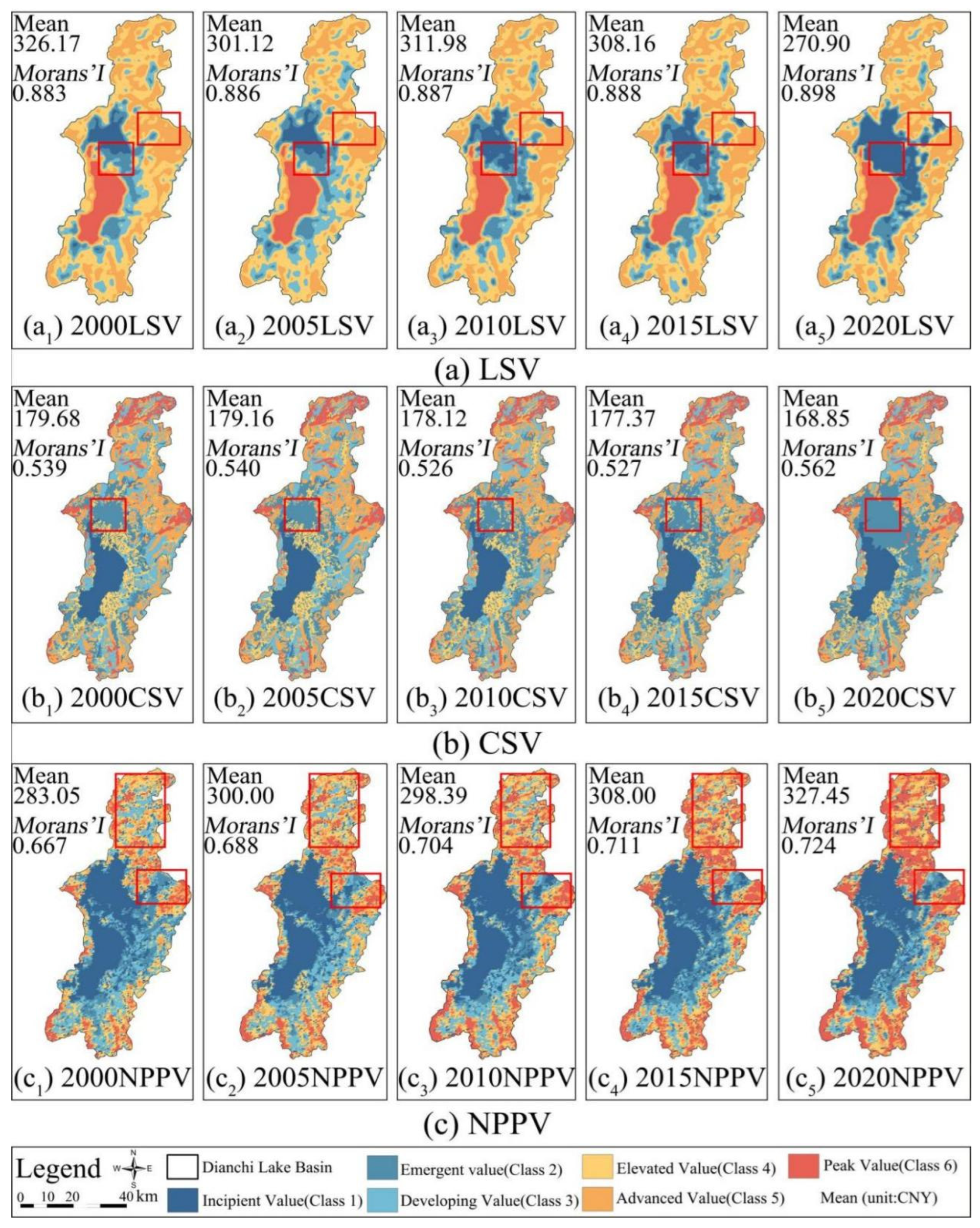

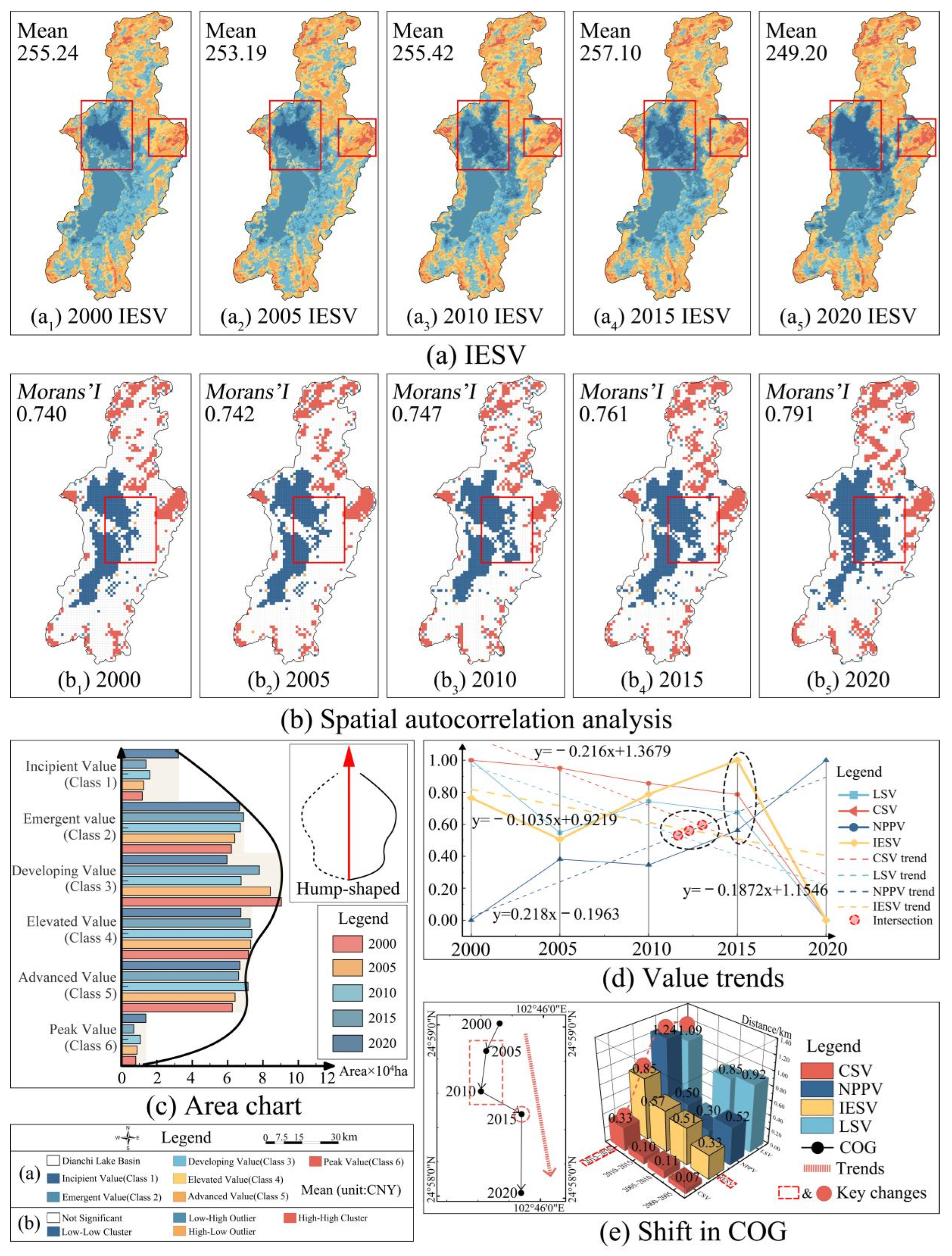
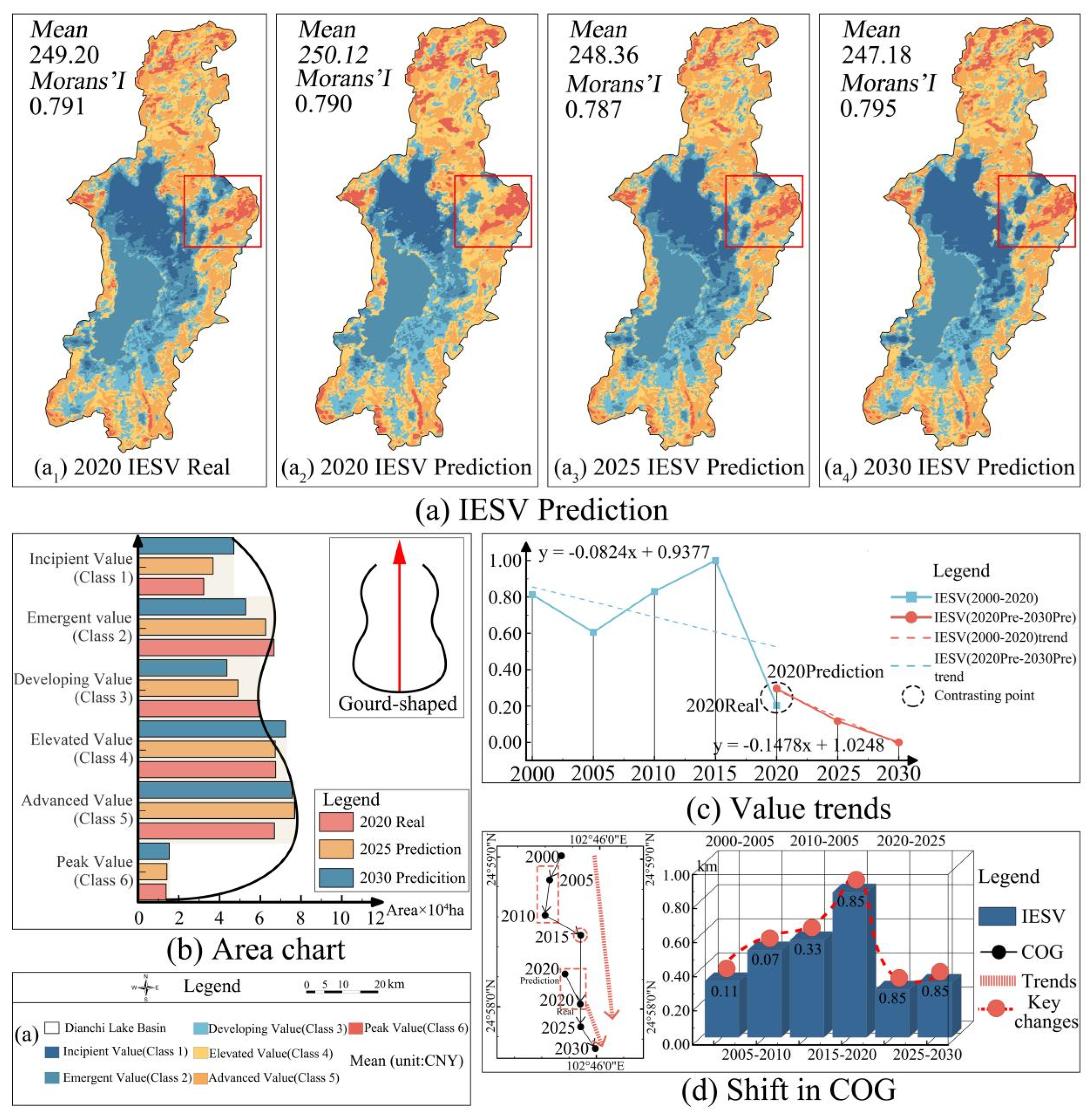
| Data Type | Data Sources | Data Time/Year | Resolution/m |
|---|---|---|---|
| Satellite data | Landsat 4–5 TM, Landsat 8 OLI_TIRS, Landsat 8–9 OLI/TIRS C2 L2 | 2000, 2005, 2010, 2015, 2020 | 30 |
| Vector data | http://geodata.pku.edu.cn (accessed on 1 December 2020) | 2020 | |
| LULC | http://www.ncdc.ac.cn/portal/ (accessed on 1 December 2020) https://www.resdc.cn/ (accessed on 1 December 2020) http://www.dsac.cn/ (accessed on 1 December 2020) | 2000, 2005, 2010, 2015, 2020 | 30 |
| Digital elevation | http://geodata.pku.edu.cn (accessed on 1 December 2020) | 2020 | 30 |
| Statistical yearbook data | https://stats.yn.gov.cn/List22.aspx (accessed on 1 December 2020) | 2000, 2005, 2010, 2015, 2020 |
| Level 1 Type | Level 2 Type | Farmland | Forestry | Grassland | Water Area | Unused Land | Construction Land |
|---|---|---|---|---|---|---|---|
| Supply services | Food production | 1.11 | 0.25 | 0.23 | 0.80 | 0.01 | 0.01 |
| Raw material production | 0.25 | 0.58 | 0.34 | 0.23 | 0.02 | 0.00 | |
| Water supply | −1.31 | 0.30 | 0.19 | 8.29 | 0.01 | −7.51 | |
| Adjust the service | Gas regulation | 0.89 | 1.91 | 1.21 | 0.77 | 0.07 | −2.42 |
| Climatic regulation | 0.47 | 5.71 | 3.19 | 2.29 | 0.05 | 0.00 | |
| Purify the environment | 0.14 | 1.67 | 1.05 | 5.55 | 0.21 | −2.46 | |
| Hydrologic regulation | 1.50 | 3.74 | 2.34 | 102.24 | 0.12 | 0.00 | |
| Support services | Soil conservation | 0.52 | 2.32 | 1.47 | 0.93 | 0.08 | 0.02 |
| Maintain nutrients | 0.16 | 0.18 | 0.11 | 0.07 | 0.01 | 0.00 | |
| Biodiversity | 0.17 | 2.12 | 1.34 | 2.55 | 0.07 | 0.34 | |
| Cultural | Aesthetic landscape | 0.08 | 0.93 | 0.59 | 1.89 | 0.03 | 0.01 |
| Level 1 Type | Level 2 Type | Farm Land | Forestry | Greens Ward | Water Area | Unused Land | Construction Land |
|---|---|---|---|---|---|---|---|
| Supply services | Food production | 0.29 | 0.07 | 0.06 | 0.21 | 0.00 | 0.00 |
| Raw material production | 0.07 | 0.15 | 0.09 | 0.06 | 0.01 | 0.00 | |
| Water supply | −0.35 | 0.08 | 0.05 | 2.20 | 0.00 | −1.99 | |
| Adjust the service | Gas regulation | 0.24 | 0.51 | 0.32 | 0.20 | 0.02 | −0.64 |
| Climatic regulation | 0.12 | 1.52 | 0.85 | 0.61 | 0.01 | 0.00 | |
| Purify the environment | 0.04 | 0.44 | 0.28 | 1.47 | 0.06 | −0.65 | |
| Hydrologic regulation | 0.40 | 0.99 | 0.62 | 27.15 | 0.03 | 0.00 | |
| Support services | Soil conservation | 0.14 | 0.62 | 0.39 | 0.25 | 0.02 | 0.01 |
| Maintain nutrients | 0.04 | 0.05 | 0.03 | 0.02 | 0.00 | 0.00 | |
| Biodiversity | 0.05 | 0.56 | 0.36 | 0.68 | 0.02 | 0.09 | |
| Cultural services | Aesthetic landscape | 0.02 | 0.25 | 0.16 | 0.50 | 0.01 | 0.00 |
| Total | 1.06 | 5.23 | 3.21 | 33.36 | 0.18 | −3.19 | |
| Land Use Type | Ci_above | Ci_soil | Ci_below | Ci_dead | Total Carbon |
|---|---|---|---|---|---|
| Farmland | 6.15 | 55.60 | 4.06 | 0.48 | 66.29 |
| Forestry | 55.17 | 308.46 | 11.03 | 1.10 | 375.76 |
| Greensward | 5.52 | 28.38 | 19.33 | 2.92 | 56.15 |
| Water | 0.00 | 14.78 | 0.00 | 0.00 | 14.78 |
| Construction land | 6.38 | 22.17 | 1.28 | 0.00 | 29.83 |
| Unused land | 0.73 | 15.35 | 0.72 | 2.19 | 18.99 |
| Item | Content | Source |
|---|---|---|
| NPP and Carbon Storage Value Estimation Method | Using the energy substitution method, estimating by converting to standard coal quality and using market price | [40] |
| Standard Coal Price (2020) | CNY 522.22–603.33 CNY/ton (based on market price and heat conversion) | [41,42] |
| Coal conversion to standard coal prices | Standard coal unit price = Raw coal unit price raw coal quantity/Standard coal quantity | [43] |
| Calorific Value of Standard Coal | 7000 kcal (complete combustion) | |
| Organic Matter to Standard Coal Energy Conversion | 1 gC = 1.474 g standard coal | [44] |
| Afforestation Cost | 305 CNY/t (using market price) | [45] |
| ESV (CNY) | 464.43–585.82 CNY/t (after deducting afforestation costs) | |
| ESV (USD) | 67.31–84.90 USD/t (converted at 2020 exchange rate) |
| Level | No. | LSV (104) | NPPV (103) | CSV (103) | IESV (×103) | |
|---|---|---|---|---|---|---|
| Low- yield areas | Incipient Value | 1 | −0.33–−0.11 | 0.56–1.54 | 0.00 | −0.93–0.08 |
| Emergent Value | 2 | −0.11–0.10 | 1.54–2.73 | 0.00–0.68 | 0.08–1.38 | |
| Developing Value | 3 | 0.10–0.24 | 2.73–3.51 | 0.68–1.16 | 1.38–2.25 | |
| High- yield areas | Elevated Value | 4 | 0.24–0.40 | 3.51–4.29 | 1.16–1.69 | 2.25–3.21 |
| Advanced Value | 5 | 0.40–0.75 | 4.29–5.07 | 1.69–3.26 | 3.21–5.63 | |
| Peak Value | 6 | 0.75–1.09 | 5.07–6.98 | 3.26–6.15 | 5.63–7.96 | |
| Indicators | LSV | NPPV | CSV |
|---|---|---|---|
| Positive ideal solution | 0.36 | 0.40 | 0.25 |
| Negative ideal solution | 0.01 | 0.02 | 0.01 |
| Sum of squares | 0.25 | 0.32 | 0.06 |
| Optimal distance | 0.50 | 0.56 | 0.25 |
| Sum of squares | 0.21 | 0.28 | 0.21 |
| Worst distance | 0.46 | 0.52 | 0.46 |
| Proximity | 0.48 | 0.48 | 0.64 |
| Weight | 0.29 | 0.32 | 0.39 |
| Level | Actual Raster | Prediction Raster | Forecast Consistency | Accuracy (%) | |
|---|---|---|---|---|---|
| Low-yield areas | Incipient Value | 357,252 | 305,111 | 280,620 | 78.55 |
| Emergent Value | 740,866 | 660,016 | 483,968 | 65.32 | |
| Developing Value | 552,065 | 582,026 | 444,173 | 80.46 | |
| High-yield areas | Elevated Value | 748,962 | 919,800 | 620,022 | 82.78 |
| Advanced Value | 854,721 | 698,121 | 514,667 | 60.21 | |
| Peak Value | 153,038 | 240,596 | 115,979 | 75.78 | |
Disclaimer/Publisher’s Note: The statements, opinions and data contained in all publications are solely those of the individual author(s) and contributor(s) and not of MDPI and/or the editor(s). MDPI and/or the editor(s) disclaim responsibility for any injury to people or property resulting from any ideas, methods, instructions or products referred to in the content. |
© 2025 by the authors. Licensee MDPI, Basel, Switzerland. This article is an open access article distributed under the terms and conditions of the Creative Commons Attribution (CC BY) license (https://creativecommons.org/licenses/by/4.0/).
Share and Cite
Bai, T.; Yang, J.; Wang, X.; Su, R.; Cushman, S.A.; Lawson, G.; Liu, M.; Wang, G.; Li, D.; Wang, J.; et al. Multi-Source Data-Driven Spatiotemporal Study on Integrated Ecosystem Service Value for Sustainable Ecosystem Management in Lake Dianchi Basin. Sustainability 2025, 17, 3832. https://doi.org/10.3390/su17093832
Bai T, Yang J, Wang X, Su R, Cushman SA, Lawson G, Liu M, Wang G, Li D, Wang J, et al. Multi-Source Data-Driven Spatiotemporal Study on Integrated Ecosystem Service Value for Sustainable Ecosystem Management in Lake Dianchi Basin. Sustainability. 2025; 17(9):3832. https://doi.org/10.3390/su17093832
Chicago/Turabian StyleBai, Tian, Junming Yang, Xinyu Wang, Rui Su, Samuel A. Cushman, Gillian Lawson, Manshu Liu, Guifang Wang, Donghui Li, Jiaxin Wang, and et al. 2025. "Multi-Source Data-Driven Spatiotemporal Study on Integrated Ecosystem Service Value for Sustainable Ecosystem Management in Lake Dianchi Basin" Sustainability 17, no. 9: 3832. https://doi.org/10.3390/su17093832
APA StyleBai, T., Yang, J., Wang, X., Su, R., Cushman, S. A., Lawson, G., Liu, M., Wang, G., Li, D., Wang, J., Zhang, J., & Wu, Y. (2025). Multi-Source Data-Driven Spatiotemporal Study on Integrated Ecosystem Service Value for Sustainable Ecosystem Management in Lake Dianchi Basin. Sustainability, 17(9), 3832. https://doi.org/10.3390/su17093832









